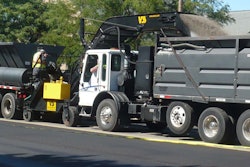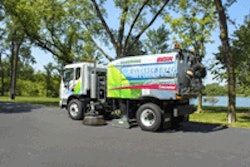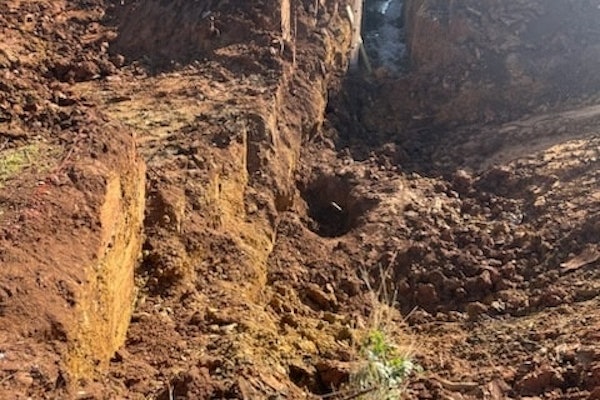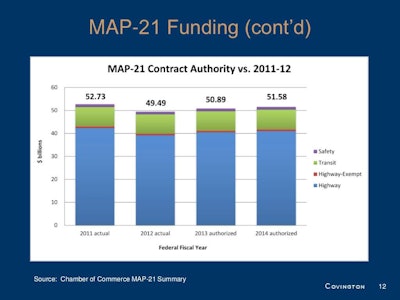
The $105 billion, 27-month legislation, Moving Ahead for Progress in the 21st Century, a.k.a. MAP-21, that passed on July 5 authorizes funding for highways, highway safety and transit for fiscal years 2013 and 2014 at a level slightly higher than fiscal year 2012 but slightly below Safe, Accountable, Flexible, Efficient Transportation Equity Act — A Legacy for Users, or SAFETEA-LU, the previous surface transportation bill that expired on Sept. 30, 2009 and underwent 10 extensions before Congress made comprises to move the bill forward for President Obama’s signature.
However, resting easier might end up being a short nap for the industry. “This was a tortuous process, but it was ultimately successful,” Jack Schenendorf, of counsel with the Washington, D.C.-based law firm Covington & Burling LLP, said in the “MAP-21: What’s in it for my business?” webinar hosted by the National Stone, Sand & Gravel Association (NSSGA). “[However], I think there has been a loss of credibility in the [highway] program. MAP-21 is being referred to as ‘devolution lite.’”
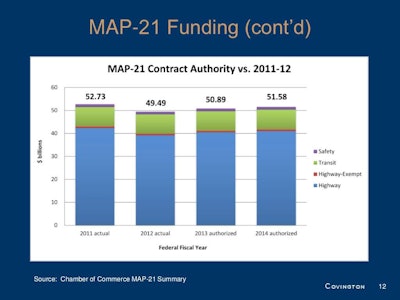
Despite these negatives, there is some good to come from MAP-21 besides just short-term funding, Schenendorf noted. There are programmatic reforms regarding consolidation, formulas, earmarks, enhancements, and freight. Performance management and streamlining are also positive outcomes. The consolidation establishes four core programs – the National Highway Performance System, the surface transportation program, the Highway Safety Improvement program, CMAW program — plus metropolitan planning. The consolidation also reduces the number of programs — e.g. interstate maintenance, bridges, safer routes to schools, recreations trails, etc. — by two-thirds
The new law requires the U.S. Department of Transportation to establish performance standards within 18 month in several areas, including safety, infrastructure condition, congestion reduction, system reliability, freight movement, environmental sustainability, and reduced project delivery delays. The performance standards only may be established after the DOT consults and coordinates with states, transit agencies, stakeholders, and metropolitan planning organizations (MPOs). Performance targets must then be established within a year after the DOT establishes performance standards, Schenendorf said. “MPOs must establish performance targets within 180 days of a state adopting performance targets, [and] performance measures and targets must be incorporated into long-range planning and short-term programming processes.”
The program will be run around these performance standards. “This is really changing how money is reinvested,” Schenendorf says. “It’s more of a performance-based approach.
What does the future hold?
Now that the bill has passed, it’s time to move ahead to implementation, regulation and ultimately reauthorization. “The next Congress will have to go through a similar process, and it’s right around the corner,” Schenendorf said. “A lot will be happening as we go forward. We will face very significant challenges. We all know what needs to be done — there needs to be more revenue in the Highway Trust Fund (HTF).”
In the short-term, the gas tax is still the best vehicle to raise money. Alternative measures, such as vehicle miles travelled, or VMT, does not produce enough revenue, Schenendorf purports. In the long-term, funding — even through the gas tax — poses problems, he says.
That’s where a new strategy comes in: innovative thinking. Two of the best opportunities might be tax reform and grand bargaining. “Early next year there will be a lot of talk of tax reform and grand bargain,” Schenendorf said. “There is a very strong feeling that these might be the best way to get the gas tax increase.”
If tax reform and a grand bargain are unsuccessful — or Congress merely puts off both — the industry faces the reality of achieving this through a standalone transportation bill, which Schenendorf says, may be very difficult. “Everyone is taking a deep breath after MAP-21 passed,” Schenendorf said. “It’s going to be important to very carefully monitor and participate. This requires a lot of regulations to be written. It will be important for the DOT to make sure it gets it right. Start planning for reauthorization now. They’ll have 18 months to do it once the new Congress comes in.”
For the PowerPoint presentation from the Webinar, go to www.slideshare.net/nssga/nssga-map-21.




